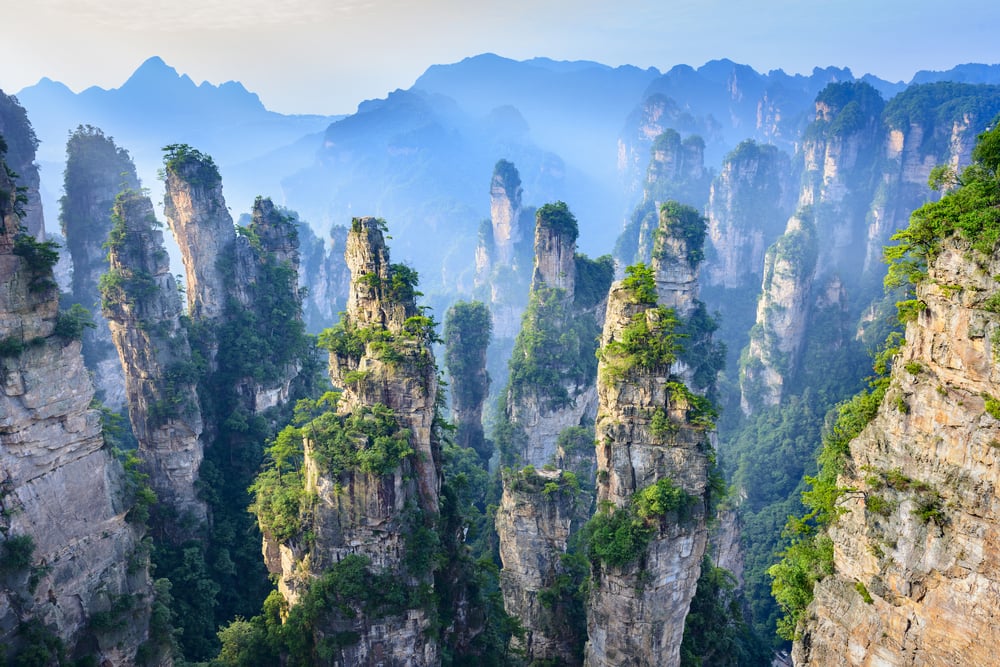
Why is Zhangjiajie National Forest Park Important?
Zhangjiajie National Forest Park is probably the most coveted part of the area. The park is comprised of dense forests, deep ravines, deep canyons, unusual peaks, caves, and pillar-like rock formations blanketed throughout the park. These pillar rock formations are what the park is renowned for around the world.
Unique Landscape and Geology
Zhangjiajie National Forest Park is renowned for its unique and dramatic landscape, characterized by:
-
Quartz Sandstone Peaks: Thousands of towering sandstone pillars dominate the park, many reaching heights of over 200 meters (660 feet). These formations are the result of millions of years of erosion, with wind and water slowly carving away at the sandstone.
-
Abundant Greenery: The park is a lush green paradise, with dense forests covering the mountainsides and valleys. This verdant landscape is home to a diverse range of plant species, contributing to the park's rich biodiversity.
-
Caves and Water Features: In addition to the iconic pillars, Zhangjiajie boasts numerous caves, underground rivers, and waterfalls, adding to the park's geological diversity and allure.
| Geological Feature | Description |
|---|---|
| Quartz Sandstone Pillars | Towering formations sculpted by erosion, some exceeding 200 meters in height. |
| Golden Whip Stream | A pristine stream meandering through the park, reflecting the surrounding peaks. |
| Yellow Stone Village (Huangshizhai) | A scenic area offering panoramic views of the sandstone pillars, especially breathtaking at sunrise and sunset. |
Ecological Significance
Beyond its scenic beauty, Zhangjiajie National Forest Park is a haven for biodiversity, playing a crucial role in:
-
Flora and Fauna: The park provides a habitat for a wide variety of plant and animal species, including many rare and endangered ones.
-
Forest Ecosystem: The dense forests act as a vital carbon sink, absorbing carbon dioxide from the atmosphere and mitigating climate change.
-
Watershed Protection: The park's forests help regulate water cycles, ensuring clean water sources for the surrounding regions.
| Ecological Importance | Description |
|---|---|
| Subtropical Forest Ecosystem | Home to over 500 species of trees, including rare dove trees and Chinese redwoods. |
| Endangered Species Habitat | Provides refuge for animals like the clouded leopard, Chinese giant salamander, and the Reeves's pheasant. |
| Air and Water Purification | Forests act as natural filters, improving air quality and regulating water flow. |
Cultural and Historical Value
Zhangjiajie National Forest Park also holds significant cultural and historical importance:
-
Inspiration for Art and Literature: The park's breathtaking scenery has long inspired Chinese artists and poets, featuring prominently in traditional paintings and poems.
-
Minority Cultures: The area surrounding the park is home to several ethnic minority groups, each with their unique traditions and customs.
-
Tourism and Recreation: The park serves as a major tourist destination, drawing visitors from all over the world and contributing to the local economy.
| Cultural Aspect | Significance |
|---|---|
| Influence on Avatar | The park's otherworldly landscape served as inspiration for the floating mountains in the movie "Avatar." |
| Tujia and Miao Ethnic Groups | Indigenous cultures known for their vibrant clothing, music, and traditional craftsmanship. |
| UNESCO World Heritage Site | Recognized for its outstanding universal value, contributing to global heritage preservation. |
FAQs
Q: When is the best time to visit Zhangjiajie National Forest Park?
A: Spring (April-May) and autumn (September-October) are generally considered the best times to visit, offering pleasant weather and colorful foliage.
Q: How do I get to Zhangjiajie National Forest Park?
A: The park is accessible by air, train, and bus. The nearest airport is Zhangjiajie Hehua International Airport (Wulingyuan).
Q: How long should I plan for a visit to the park?
A: To fully experience the park's highlights, it is recommended to allocate at least 2-3 days for your visit.